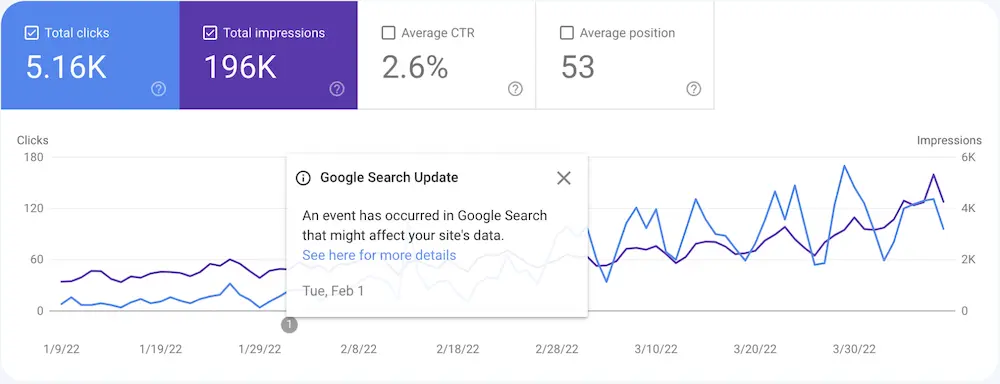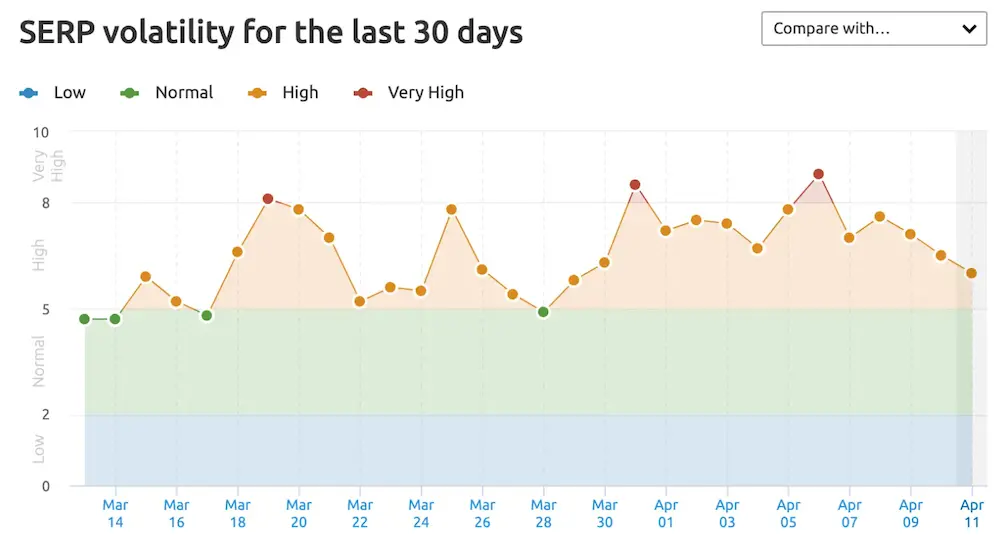What Is SERP Volatility? Causes, Trackers & How To Fix
If you’ve witnessed your webpage rankings bouncing around like a kid on a pogo stick, you may be wondering what the hell is going on. Your answer is SERP (search engine results page) volatility—an unfortunate quirk of search engines that can cause havoc in your website traffic. Thankfully, there’s a way to reduce SERP volatility and make your rankings more stable.
But before we jump into the solution, let’s first explore what SERP volatility actually is, and what causes it to happen.
What is SERP volatility (Google ranking changes)?
SERP volatility for the entire “Home & Garden” industry, from the Semrush Sensor tool
SERP volatility is a measure of how unstable webpage rankings are in a search engine’s results page. A webpage rarely settles into a certain position for a long period of time. Instead, it jumps up and down, sometimes by one or two spots, and sometimes seeming to disappear and reappear entirely from the search engine’s index. The extremity of these changes is how volatile the SERP is. When we talk about SERP volatility, we’re often talking about Google ranking changes, but the term applies to every search engine.
Semrush did a study last year that looked at SERP volatility for common industries in the U.S. They measured the top 20 search results across a monthly period, and found an average volatility of 4.8 across desktop and mobile.1 That means that on average, webpages shifted 4.8 places during that time.
While SERP volatility is technically a measurement of a webpage’s ranking movement, the page usually has different rankings for different keyword phrases. A webpage that teaches you about the Australian Emu War of 1932 might sit at the number one spot for “Emu War,” the number three spot for “Great Emu War,” and the number ten spot for “Sir George Pearce,” who waged modern warfare against the rabid band of emus but utterly failed to control them. We highly recommend reading about this amusing piece of Australian history.
We believe that SERP volatility is mostly due to search engines testing which webpages are relevant and useful for the user. There’s billions of pages on the internet, and a search engine has to decide which to select and show to their users, and in which order. They can’t do this without moving results around and testing whether people click on them and engage with them in a positive way.
That’s a summary of what causes SERP volatility—here’s a more in depth look.
SERP volatility causes
CTR testing
As mentioned above, it’s extremely tough for a search engine to know whether a page is relevant and helpful for people unless they look at how they interact with it. And one of the biggest measures of whether a page is relevant is whether they read the title and decide to click on it. This measurement is expressed as CTR (click through rate), which is the number of people who saw the listing divided by the number of people who clicked on it, which gives you a percentage. The higher the CTR, the more likely it is that the webpage is relevant to the user’s search query, and the bigger the ranking boost it will get.
So when a new webpage is published, or an old page has had significant changes made to it, how does a search engine know whether it’s relevant to the user? They give it a temporary ranking boost and see whether people click on it (it’s likely that they measure how people interact with the page too—called user signals). If the CTR for the page rises by an amount that the search engine considers to be high, it can assume that the page is solid, and can increase its ranking with confidence. If the CTR doesn’t rise by as much as the search engine expects, it reaches the opposite conclusion: the page is probably less relevant to the user’s search query. This is how some webpage rankings can quickly build momentum until they soar to the number one position, or lose momentum and plummet into the abyss.
On the subject of CTR testing, we wrote an article about how to improve CTR for your webpages. This can make a big difference to your click rates and give you a solid SEO boost.
Search intent testing
When people complete searches, their intention can be grouped into a number of common categories. They could be looking for information (informational intent), looking to buy something (transactional intent), or be looking for a specific webpage that is easier to find by just Googling it (navigational intent). This is known as user intent, and some search queries have a mixture of them, which makes it difficult for the search engine to know what kinds of results to show.
For example, if you search for “lawn mowers,” you might be looking to purchase a lawn mower directly, or be trying to find out information about the best lawn mowers to buy. So in this case, a search engine may decide to show you a mixture of shopping and informational results, and then see which of them you click on most often. You can be sure that the results with a higher CTR will rise in the rankings, and the results with a lower CTR will drop, which gives the search engine a more accurate idea of what portion of results should be transactional, and which should be informational. And to keep that portion accurate as time goes on, they may increase or decrease the rankings for websites they include in their listings, which is what makes them volatile.
Algorithm updates
According to Google’s former head of search quality Matt Cutts, the search engine tends to make about 350 to 400 changes to its algorithm each year.2 And every one of those changes can affect the rankings of webpages, contributing to SERP volatility.
Sometimes, those updates are major, like Google’s recent focus on Core Web Vitals. When this happens, Google adds a date marker to their Search Console software to let people know when the major updates took place, so they can see whether it might have affected their clicks and impressions. That’s why it’s important to stay on top of big ranking updates and make any necessary changes to your webpages before they go live.

Webpage changes
As you can see, most of SERP volatility is caused by the search engines themselves. But it can also be caused by updates to your webpages. This can be pretty much any change that affects how the user might interact with your website, including content changes, structural changes, and even design changes. If you make updates that lead to more clicks on a webpage, longer view times, and more interactions with the various elements like buttons and forms, the search engines consider these to be positive user signals, and may increase the page’s ranking as a result.
That’s one reason why SEO is so crucial—it can lead to positive user experiences for people, which tells Google that your webpages are awesome and deserve to be seen.
How to track SERP volatility
You can track the SERP volatility of your webpages and their ranking keyword phrases with a software tool. There’s a variety to choose from, each with their pros, cons, and different pricing, so you’ll need to do some further research to figure out which is best.
These are some common tools you can choose from:
- Mangools
- Google Grump
- Algoroo
- Cognitive SEO
- Mozcast
- Rank Ranger
- Semrush (Volatility Sensor feature)
- Serpwoo
How to reduce SERP volatility
SERP volatility is a natural occurrence, but that doesn’t mean you can’t reduce it and stabilise your rankings a little better. High keyword rankings can have a huge impact on your revenue (especially if you get a lot of business from your website), so reducing SERP volatility can be a worthy time investment. Here are some of the best ways to do it.
Match the user’s search intent with excellent content
This is the most effective thing you can do to reduce SERP volatility. Remember that search engines want to show the most relevant information to their users, so when your content is well-researched, well-written, more comprehensive than the competition’s, and matches the user’s search intent, you have a solid chance of ranking highly. This is no small feat, and can require a lot of work to get right. But the rewards can be enormous, which is why content marketing is such an effective long-term marketing strategy.
Write amazing content that your users want and need, and you’ll eventually reap the rewards. We covered this in our article on the link between SEO and content marketing.
Avoid keywords with mixed search intents
If the keywords you are targeting for your content have mixed search intents, where it’s hard to tell whether the user is looking for information about something, looking to buy something, or looking to find a particular website, you can expect much more SERP volatility for your webpage. As we discussed above, this is due to the search engine consistently testing out pages with different search intents to see which of them are more popular with their users. So if you can, avoid keywords with mixed search intents.
Build authority for your topics
If you’re a business consultant who has spent a good amount of time creating business-related content for your website, including informative page content, enlightening blogs, and stellar videos, eventually, the major search engines will recognise your value and start to lift your rankings. You have dedicated time and energy to build authority for business related topics, and so your rankings will climb and become much less volatile.
If your rankings are bouncing all over the place, you may need to create more content that convinces the search engines that you know your stuff. Brainstorm topics that are related to the volatile webpages, find common keywords that match the topics, and then write thorough blogs about them. The more high-quality content you create for your target topics, the more authority you’ll build with search engines, and the more stable your webpages will become.
Stay on top of major algorithm updates
Sometimes search engines make big changes to their algorithms which can have a drastic effect on your website’s rankings. So it’s important to stay on top of the major algorithm updates from Google, Bing, DuckDuckGo, and other search engines where you get a decent amount of traffic to your site. It can be tricky to find this info, but if you make a note to regularly search for “upcoming [search engine] algorithm update,” or something along those lines, you should be in good stead.
From there, you can find out more about the updates and how to prepare for them. Try to view these updates as opportunities rather than problems—if you tackle them before your competitors, you could reduce SERP volatility and get a big SEO boost that helps to surge ahead of them.
References
- Connor Lahey, 2021, Analyzing Google SERP Volatility Across 25 Industries, Semrush
- Dr Peter J Meyers, 2019, How Often Does Google Update Its Algorithm? Moz



